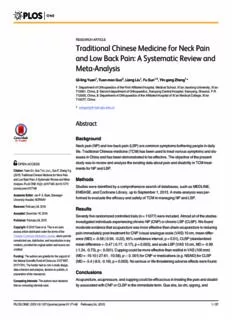
Traditional Chinese Medicine for Neck Pain and Low Back Pain PDF
Preview Traditional Chinese Medicine for Neck Pain and Low Back Pain
RESEARCHARTICLE Traditional Chinese Medicine for Neck Pain and Low Back Pain: A Systematic Review and Meta-Analysis Qi-lingYuan1,Tuan-maoGuo2,LiangLiu1,FuSun1,3,Yin-gangZhang1* 1 DepartmentofOrthopaedicsoftheFirstAffiliatedHospital,MedicalSchool,Xi’anJiaotongUniversity,Xi’an 710061,China,2 SeconddepartmentofOrthopaedics,XianyangCentralHospital,Xianyang,Shaanxi,P.R. 712000,China,3 DepartmentofOrthopaedicsoftheAffiliatedHospitalofXi’anMedicalCollege,Xi’an 710077,China * [email protected] Abstract Background Neckpain(NP)andlowbackpain(LBP)arecommonsymptomsbotheringpeopleindaily life.TraditionalChinesemedicine(TCM)hasbeenusedtotreatvarioussymptomsanddis- easesinChinaandhasbeendemonstratedtobeeffective.Theobjectiveofthepresent OPENACCESS studywastoreviewandanalyzetheexistingdataaboutpainanddisabilityinTCMtreat- mentsforNPandLBP. Citation:YuanQ-l,GuoT-m,LiuL,SunF,ZhangY-g (2015)TraditionalChineseMedicineforNeckPain andLowBackPain:ASystematicReviewandMeta- Methods Analysis.PLoSONE10(2):e0117146.doi:10.1371/ Studieswereidentifiedbyacomprehensivesearchofdatabases,suchasMEDLINE, journal.pone.0117146 EMBASE,andCochraneLibrary,uptoSeptember1,2013.Ameta-analysiswasper- AcademicEditor:JanP.A.Baak,Stavanger formedtoevaluatetheefficacyandsafetyofTCMinmanagingNPandLBP. UniversityHospital,NORWAY Received:February24,2014 Results Accepted:December18,2014 Seventyfiverandomizedcontrolledtrials(n=11077)wereincluded.Almostallofthestudies Published:February24,2015 investigatedindividualsexperiencingchronicNP(CNP)orchronicLBP(CLBP).Wefound Copyright:©2015Yuanetal.Thisisanopen moderateevidencethatacupuncturewasmoreeffectivethansham-acupunctureinreducing accessarticledistributedunderthetermsofthe painimmediatelypost-treatmentforCNP(visualanaloguescale(VAS)10cm,meandiffer- CreativeCommonsAttributionLicense,whichpermits ence(MD)=-0.58(-0.94,-0.22),95%confidenceinterval,p=0.01),CLBP(standardized unrestricteduse,distribution,andreproductioninany medium,providedtheoriginalauthorandsourceare meandifference=-0.47(-0.77,-0.17),p=0.003),andacuteLBP(VAS10cm,MD=-0.99 credited. (-1.24,-0.73),p<0.001).CuppingcouldbemoreeffectivethanwaitlistinVAS(100mm) Funding:Theauthorsaregratefulforthesupportof (MD=-19.10(-27.61,-10.58),p<0.001)forCNPormedications(e.g.NSAID)forCLBP theNaturalScientificFundofChina(no.81371987, (MD=-5.4(-8.9,-0.19),p=0.003).Noseriousorlife-threateningadverseeffectswerefound. 81171761).Thefunderhadnoroleinstudydesign, datacollectionandanalysis,decisiontopublish,or Conclusions preparationofthemanuscript. Acupuncture,acupressure,andcuppingcouldbeefficaciousintreatingthepainanddisabil- CompetingInterests:Theauthorshavedeclared thatnocompetinginterestsexist. ityassociatedwithCNPorCLBPintheimmediateterm.Guasha,taichi,qigong,and PLOSONE|DOI:10.1371/journal.pone.0117146 February24,2015 1/37 TraditionalChineseMedicineforNeckandLowBackPain Chinesemanipulationshowedfaireffects,butwewereunabletodrawanydefiniteconclu- sions,andfurtherresearchisstillneeded.Theefficacyoftuinaandmoxibustionisunknown becausenodirectevidencewasobtained.TheseTCMmodalitiesarerelativelysafe. Introduction Neckpain(NP)andlowbackpain(LBP)arecommonsymptomsbotheringpeopleindaily life.Indevelopedcountries,morethan70%ofpeopleexperienceLBP[1],whereasapproxi- matelytwo-thirdsofpeopleexperienceNP[2,3]atsomepointintheirlifetimes.Thesetwodis- ordersoccurmostfrequentlyamongthemiddle-agedpopulation,inwhichtheproportionof femalesishigherthanthatofmales[4].AmajorityoftheacuteNPandLBPsufferersobtain spontaneousreliefwithindaysorweeks,althoughapproximately10%ofacuteNP[2]and20% ofacuteLBP[5]suffersexperiencetheconditionaschronicorpersistent.NPandLBPcanbe causedbyspecificpathologicaldiseases,suchastumors,infection,fracture,andinflammation. However,thepaininmostindividuals(approximately85%forLBP)[1]isnon-specific,which indicatesthatthepainisnotattributabletooneofthedefiniteabovepathologiesbutinsteadto someambiguousetiology.Conventionaltreatments,suchasmedications[6]andsurgery[7], havedemonstratedsomeefficacy.Nonetheless,thesetreatmentswerenotalwayseffective,and evenhadsomeseriousadverseeffects[7,8].Consequently,tofindsomemoreeffectivethera- peuticmethods,manyindividualshaveturnedtheirattentiontosomeothertreatments,such ascomplementaryandalternativemedicine(CAM).AlthoughCAMmayalsohavesomead- verseeffectsofitself,giventhenumeroustherapeuticmethodsofCAManditspositiveeffec- tivenesstosomeextent,agrowingnumberofresearchershavefocusedonvariousCAM therapies,suchasacupuncture,massage,exercise,andhydrotherapy[9].Mostsignificantly,as atypeoftraditionalChinesemedicine(TCM),acupuncturehasshownrespectableefficacyand isbroadlyacceptedinternationally[10–12]. TCMisbasedonthefundamentaltheoryofbalanceamongyinandyang,fivebasicele- ments,andarelationshipbetweenhumansandnature[13,14].TCMhasbeenusedtotreatvar- iousdiseasesinChinaandeventhroughoutEastAsiaformorethan2000years,anditstill remainsthefirstchoiceoftreatmentformanypeople.However,thedifferentmodelsof thoughtthatarethefoundationsofTCMandmodernsciencearenotcompatible,hindering thespreadofTCMworldwide.Nevertheless,therearemanyarticlespublishedinvariousscien- tificjournalsthathaveattemptedtoexplainsomephenomenaandmechanismsoftreatments inTCMfromtheperspectiveofmodernmedicine. AlthoughacupunctureisatypicalrepresentativeofTCM,itisonlyoneofthevariousgener- altherapiesforNPandLBP,suchasacupressure,cupping,moxibustion,tuina,guasha,taichi, qigong,Chineseherbalmedicine,andChinesemanipulation(fordefinitions,seeS1Table). Theobjectiveofthepresentstudywastoreviewandanalyzetheexistingdataaboutpainand disabilityassociatedwithTCMtreatmentsforNPandLBP.Thequestionofourstudyis “whetherTCMtreatmentsaremoreeffectiveinpainreliefordisabilityimprovementascom- paredwithothertreatmentsforpeoplewithNPorLBP?”. Methods DataSourcesandSearchStrategy Studieswereidentifiedbyacomprehensivesearchinthefollowingdatabases:MEDLINE, EMBASE,theCochraneLibraryandtheTraditionalChineseMedicalLiteratureAnalysisand PLOSONE|DOI:10.1371/journal.pone.0117146 February24,2015 2/37 TraditionalChineseMedicineforNeckandLowBackPain RetrievalSystem(TCMLARS)andChinaNationalKnowledgeInfrastructure(CNKI)andthe WanFangdatabase.Thesearchwasconductedbetweentheinceptionofeachdatabaseand September1,2013,andupdatedonMay25,2014usingdisease-specificsearchstringcombina- tions,partlyaccordingtothestrategyoutlinedbytheCochraneBackReviewGroup(CBRG) (S2Table),withsubjectlimitationswithintheEnglishorChineselanguage.Therewerenore- strictionsaboutpublicationstatusofthesearchedtrials.Thereferencelistsofidentifiedstudies werescreenedmanuallyformorestudiesrelated.Expertsintherepresentativefieldswerealso contactedforunpublishedtrials.Thesearchwasconductedbyaveteranlibrarian. StudySelectionCriteria Weincludedanyrandomizedcontrolledtrial(RCT)meetingallofthefollowingcriteria:(1) theworkispublishedintheEnglishorChineselanguage;(2)thesubjectsincludedaremenor women(age(cid:1)17years)withNPorLBP(withorwithoutradiatingpain)ofanyduration;(3) atleastoneofthetherapiesassessedpertainstoTCM;(4)acomparisonshouldbedonebe- tweenTCMandothertreatment(e.g.TCMversusothertreatment,TCMversusnotreatment, TCMplusothertreatmentversusothertreatment);(5)atleastoneofthefollowingoutcomes wasevaluated:painintensityordisability;(6)theprinciplesummarymeasuresshouldbetter becommonlyused,suchaspainintensity(e.g.,visualanaloguescale,VAS;numericalrating scale,NRS)anddisability(e.g.,OswestryDisabilityIndex,ODI;NeckDisabilityIndex,NDI); (7)thedurationoffollow-upshouldbeatleastonedayafteralltreatmentsessionswerecon- cludedaccordingtothestudydesignofeachcorrespondingtrial. Weexcludedtrialsofneckorbackpaincausedbytrauma,infection,caudaequinasyn- drome,bonerarefaction,compressionfractureofavertebralbody,tumor,orfibromyalgia. DataExtraction TwoevaluatorsindependentlyextractedthedatafromthestudiesorSRs,anddiscrepancies wereresolvedbynegotiationorathirdparty. Thedurationofpainwasdefinedasfollows:(1)chronic((cid:1)3months);(2)sub-acute(~1–3 months);and(3)acute(<1month).Incontrast,thefollow-up(post-intervention)timeswere definedasfollows:(1)immediateterm((cid:3)1week);(2)shortterm((cid:3)3months);(3)intermedi- ateterm(~3–12months);and(4)longterm((cid:1)1year). Primaryoutcomesincludedpainintensity(e.g.,visualanaloguescale,VAS;numericalrating scale,NRS)anddisability(e.g.,OswestryDisabilityIndex,ODI0–60points).Additionally,side effects(includingthenamesofadverseeffectsandthenumberorproportionofindividuals experiencingthem)wererecorded. Thestudy,treatment,population,andoutcomecharacteristicsaresummarizedintables. AssessmentofStudyQualityandReporting Twoindependentassessorsevaluatedthequalityofeverytrialincludedinourreview.Discrep- ancieswereresolvedbynegotiationoranauthoritativethirdparty. ThequalityoftheindividualtrialswasratedaccordingtothecriteriaoftheCochraneBack ReviewGroup(Table1)[15].Dependingonthenumberof“Yes”responses(codedas“1”)for fourparticularitems(e.g.,allocationconcealment,baselinesimilarity,patientblinding,and numberoforreasonfordropouts),yieldingarangeofscoresfrom0–4,thequalityofindividu- altrialswasgradedaccordingtothefollowingthreeranks:good(score=4),fair(score=2–3), orpoor(score=0–1).Becausethenumberof“Yes”responseswasrecordedfor4domains,in caseofasinglestudy,Nwasawholenumber(0,1,2,3,or4);incaseofmultiplestudies,Nwas theaveragenumber,whichmayhavebeeneitherawholenumberorafraction(S3Table). PLOSONE|DOI:10.1371/journal.pone.0117146 February24,2015 3/37 TraditionalChineseMedicineforNeckandLowBackPain Table1.UpdatedMethodGuidelinesforSystematicReviewsintheCochraneCollaborationBackReviewGroup—a12ItemTool. Question Item Rating Q1 Wasthemethodofrandomizationadequate? Yes/No/Unsure Q2 Wasthetreatmentallocationconcealed? Yes/No/Unsure Q3 Werethegroupssimilaratbaselineregardingthemostimportantprognosticindicators? Yes/No/Unsure Q4 Wasthepatientblindedtotheintervention? Yes/No/Unsure Q5 Wasthecareproviderblindedtotheintervention? Yes/No/Unsure Q6 Wastheoutcomeassessorblindedtotheintervention? Yes/No/Unsure Q7 Wereco-interventionsavoidedorsimilar? Yes/No/Unsure Q8 Wasthecomplianceacceptableinallgroups? Yes/No/Unsure Q9 Wasthedrop-outratedescribedandacceptable? Yes/No/Unsure Q10 Wasthetimingoftheoutcomeassessmentinallgroupssimilar? Yes/No/Unsure Q11 Didtheanalysisincludeanintention-to-treatanalysis? Yes/No/Unsure Q12 Arereportsofthestudyfreeofsuggestionofselectiveoutcomereporting? Yes/No/Unsure doi:10.1371/journal.pone.0117146.t001 QuantitativeSynthesis Wegroupedtheresultswithrespecttotheinterventionsused(e.g.,acupuncture),thegeneral locusofthepain(e.g.,neckorlowback),thepersistenceofthepain(e.g.,acute,sub-acute,or chronic),andthecauseofpain(e.g.,specificornon-specific). Thedataabstractedwereclassifiedintocontinuousanddichotomousvariables.Generally, fixed-effectsmodels(inverse-variancemethod)wereusedinthemeta-analysis.However,we alsousedrandom-effectsmodels(DerSimonian-Lairdmethod)topooldataifthestatistical heterogeneitywashigh(I2(cid:1)50%).Thesourceofheterogeneitywasexploredbyfittingcovari- ables(ie,interventioncharacteristics,meanage,baselinetotalsymptomscores)onebyonein themeta-regression.Weanalyzedthesubgroupsaccordingtothesourceofheterogeneityif possible,andsensitivitiesiftherewereunaccountablesourcesofheterogeneity.Weusedcon- tour-enhancedfunnelplotsandEggertesttoexaminepublicationbiasifthenumberofpooled trialswerenearorabove10[16,17].AllanalyseswereperformedinSTATA12.0(StataCorp LP,CollegeStation,TX). Ifthedatapermittedtheassessmentandtherewerestatisticallysignificantdifferencesacross thepooleddatainpainreliefordisabilityimprovement,clinicalimportancewasassessedac- cordingtoCohen’s3levels(Table2)[18]. RatingtheStrengthofEvidence Theoverallstrengthofevidencewasevaluatedwiththeaidofthegradingsystemoutlinedin theMethodsGuidepreparedbytheAHRQEvidence-basedPracticeCenter(EPC)program Table2.RatingofClinicalImportance. Rating Range Small aweightedmeandifference(WMD)lessthan10%ofthescale(e.g.,<10mmona100mmVAS);astandardizedmeandifference(SMD)or “d”score<0.5;arelativeriskof<1.25or>0.8(dependingonwhetherthereportreferredtotheriskofbenefitortheriskofharm,respectively) Medium aWMDfrom10–20%ofthescale;anSMDor“d”scorefrom0.5to0.8;arelativeriskbetween1.25and2.0orbetween0.5and0.8 (dependingonthefactordescribedabove) Large aWMD>20%ofthescale;anSMDor“d”score(cid:1)0.8;arelativerisk>2.0or<0.5(dependingonthefactordescribedabove) doi:10.1371/journal.pone.0117146.t002 PLOSONE|DOI:10.1371/journal.pone.0117146 February24,2015 4/37 TraditionalChineseMedicineforNeckandLowBackPain Table3.GradingofEvidence. Grade Domain High All4domainsaremet(e.g.,lowriskofbias,precise,direct,consistent) Moderate 1ofthedomainsisnotmet(e.g.,mediumriskofbias,precise,direct,consistent) Low 2–4ofthedomainsarenotmet(e.g.,highriskofbias,precise,indirect,inconsistent) Insufficient Noevidence/absenceofevidence doi:10.1371/journal.pone.0117146.t003 [19].Theratingschemefocuseson4majordomains:riskofbias(high,medium,low),consis- tency,directness,andprecision.Consistencyindicatedthat75%ofthetrialsshowedthateffects wereinthesamedirection(positiveornegative)orthatheterogeneitywaslow(i.e.,I2<50%). Thestrengthofevidencewasclassifiedintooneoffourlevels:high,moderate,low,orinsuffi- cient(noevidence)(Table3,S4Table)[19].Thelevelwasloweredonestageifanyoftheafore- mentioneddomainswasnotmetandwasdirectlyloweredtwostagesifthetrialhadahighrisk ofbias.Additionally,thelevelwasloweredonestageifthesamplesizewassmallerthan40pa- tientspergroup(toenableadequatepower)[20]. Results Aftersearchingthedatabasesrigorouslyandsystematically,658uniquerecordswereidentified, andthetitlesandabstractswerescreened.Thefull-textof243articleswereassessedforeligibility, 75studies[21–93]wereincludedinthesystematicreview(Fig.1).Ofthesestudies,12studies [35,36,59,78–81,90–93]wereinChinese(2unpublishedtrialsaboutChineseherbalmedicine), othersinEnglish.Thekappavalueforagreementbetweenthereviewers(YQLandLL)was0.90 whichindicatedanexcellentagreement.Wefoundthatmostoftheincludedstudieswereprinci- pallyaboutacupuncture,acupressure,andcupping(Table4).Incontrast,thenumberofstudies ontheotherseventreatmentswaslessthan3(most=1)foreachtreatment.Thetreatment Fig1.FlowDiagram. doi:10.1371/journal.pone.0117146.g001 PLOSONE|DOI:10.1371/journal.pone.0117146 February24,2015 5/37 TraditionalChineseMedicineforNeckandLowBackPain Table4.Thespecificnumberofstudiesincludedandbasiccharacteristicsoftreatmentsforeachintervention. Intervention Condition Study Patients Durationofone Treatment Courseof Numberof (N) (N) treatment(minutes)$ sessions(times)$ Treatment(weeks)$ acupointsselected$ Acupuncture NP 17 1434 25(20,30) 8.5(5.8,10.5) 4(3,4.5) 6(5.8,10) LBP 31 6656 25(20,30) 10(6,12) 4.5(3.3,7) 9.8(6,14) Acupressure NP 1 32 35–40 8 3 7 LBP 5 417 15or30 8(6,9) 4(3,4) 7or18 Cupping NP 5 251 10or15 5(4,6) 2 n.a. LBP 6 415 15or20 7.5(3.5,10) 3(1.9,3) n.a. Guasha NP 2 69 15or30 1 n.a. LBP 1 19 15 1 n.a. Qigong NP 3 378 60(45,90) 18(12,18) 12 n.a. LBP 0 0 Taichi NP 0 0 LBP 1 170 40 18 10 n.a. Chineseherbal NP 3 840 n.a. 8(8,12) 4 medicine LBP 0 0 Chinese NP 3 396 20 8(8,10) 4(4,5) n.a. manipulation LBP 0 0 Moxibustion NP 0 0 LBP 0 0 Tuina NP 0 0 LBP 0 0 Total 75* 11077 LBP,lowbackpain;NP,neckpain;N,number;RCT,randomizedcontrolledtrial;n.a.,notapplicable. *Someofthestudieswereincludedintotwoormorerows. $Theresultswereshownasmedianandinterquartilerange. doi:10.1371/journal.pone.0117146.t004 sessionsandtreatmentdurationsofinterventionsalsowereshowninTable4.Thespecificresults ofourmeta-analysiswereshowninS5Table. Studycharacteristics Seventyfivestudiesinvolving11077subjectsrangingfrom17to90yearswereincluded.Ama- jorityoftheparticipantswerefemales(>60%)withchronicneckpain(CNP)orchroniclow backpain(CLBP).ThebasiccharacteristicsofthetrialswerepresentedinS6Table.Forthe findingsofourrisk-of-biasassessmentwereshowninFig.2(andS7Table).Themedianand interquartilerange(IQR)ofthequalityscoreofthestudieswas6(4.5to8),whichmeantthat theoverallqualitywereofhigher-quality.Mostofthestudiesdidn’tprovideadequateinforma- tiononoutcomeassessorblinding,co-interventionandcompliance.Giventhecharacteristics ofsomeinterventions,theblindingofthecareproviderwasunapplicable.Thestrengthofevi- denceanditsclinicalimportancewaspresentedinS8Table. AcupunctureinCNP Therewereseventeenstudies(n=1434individuals)identified[21–37].Twoofthestudies werepublishedinChinese[35,36].TheIQRofthequalityscoreofthestudieswas5(4to7). PLOSONE|DOI:10.1371/journal.pone.0117146 February24,2015 6/37 TraditionalChineseMedicineforNeckandLowBackPain Fig2.Risk-of-Biasofstudiesincluded.Q,question. doi:10.1371/journal.pone.0117146.g002 Acupunctureversussham-acupuncture Therewereseventrials(428subjects)identified[21–24,27,28,30].Weobservedsignificantdif- ferencesinpainreliefinfavorofacupuncturecomparedwiththeshamgroup(VAS10cm,MD, -0.58[-0.94,-0.22],I2=46.3%)(Fig.3andS5Table)[21–24,27,28,30],.Thecontour-enhanced funnelplotindicatedsymmetry(Fig.4)andtheEggertestsuggestedtherewasnoevidenceof publicationbias(coefficient=1.00;SE=1.05;P=0.39).Thissuperioritypersisteduntil1month post-intervention(MD,-0.72[-1.07,-0.37])[21,23],whereasafter3monthsoffollow-up,this effectgraduallydiminisheduntiltherewerenodifferencesbetweenthegroups(MD,-0.32[-0.68, 0.04])[21–23].However,withrespecttodisability(Fig.5)[21,23,24,27],thistendencyinfavorof acupuncturewasalsodisplayedintheseterms. Acupunctureversusshamtreatments(inactivetreatments) Therewerethreetrials(272subjects)identifiedthatholdcomparisonsbetweenacupuncture andshamtranscutaneouselectricalnervestimulation(TENS)[25,26,31].Comparedwith shamTENSforpain,acupuncturedidn’tdisplayanydifferencesinpainrelief(Fig.6)anddis- abilityimprovement(Fig.7)forCNPatimmediatetermandevenatshortterm(p>0.10), andtheseresultswerestillrobustinsensitivityanalysis[25,26,31].Onetrial(108subjects)com- paredacupunctureandshamlaser[29].Similarly,nodifferencewasfoundbetweenacupunc- tureandshamlaserinpainreliefimmediatelypost-treatment(p=0.202)(S5Table)[29]. Acupunctureversuswaitlist(notreatment) Onlyonetrial(30subjects)showedasignificantdifferenceinpainforCNPimmediately post-treatmentonVAS10cm,withanoddsratioof26.00(3.69to183.42,p=0.001)[37]. Acupunctureversusactivetreatments Withrespecttofindingscomparingacupuncturewithotheractivetreatments,suchasmed- icationswithaSMDof-0.57[-1.14,-0.01][30,32–34],massagewithaMDof-1.63[-2.68,-0.58] onVAS10cm[29],significantsuperiorityfavoringacupuncturewasfoundaboutpainreliefat immediateterm(p<0.05)(Fig.8andS5Table),buttheresultwasnotrobustaftersensitivity analysiswasperformed(p=0.06).Whereas,acupuncturewaseveninferiortomanipulation (SMD,-0.08[-0.49,0.32],I2=38.4%)(Fig.9)[32,33,35]andcervicaltraction(VAS10cm,MD, 1.31[0.78,1.84])(S5Table)[36]. Sideeffects PLOSONE|DOI:10.1371/journal.pone.0117146 February24,2015 7/37 TraditionalChineseMedicineforNeckandLowBackPain Fig3.Meta-AnalysisofAcupunctureversusSham-AcupunctureforCNPinPainIntensityontheVAS(0–10mm).Fixed-effectsmodelwasused;CI, confidenceinterval;CNP,chronicneckpain;SD,standarddeviation;VAS,visualanaloguescale;WMD,weightedmeandifference. doi:10.1371/journal.pone.0117146.g003 Fig4.Contour-enhancedfunnelplotofAcupunctureversusSham-AcupunctureforCNPinPain. Visualinspectionofthefunnelplotsuggestedsymmetry.Specifically,thereweremostoftrialswithnegative results(i.e.,moretrialsinareasofstatisticalnonsignificance),indicatingnoevidenceofpublicationbias. doi:10.1371/journal.pone.0117146.g004 PLOSONE|DOI:10.1371/journal.pone.0117146 February24,2015 8/37 TraditionalChineseMedicineforNeckandLowBackPain Fig5.Meta-AnalysisofAcupunctureversusSham-AcupunctureforCNPinDisability.Fixed-effectsmodelwasused;CI,confidenceinterval;CNP, chronicneckpain;SD,standarddeviation;SMD,standardizedmeandifference. doi:10.1371/journal.pone.0117146.g005 Thereweresomecomplaintsreportedinthetrials,suchaslocalbleeding,numbness,pain, andfaintingwhenneedleswereinsertedinsomesubjects.Allthesesideeffectsweretransient andmild.Nolife-threateningsideeffectswerereported[21,25,26,29]. Summary Severalstudiesshowedthattherewasmoderateevidencewithsmallclinicalimportance thatacupuncturewasmoreeffectivethansham-acupunctureinreducingpainanddisabilityas- sociatedwithCNPintheimmediatetermandattheone-monthfollow-up. AcupunctureinLBP Thirtyonestudieswithatotalof6656patientscomparedacupuncturewithothertreat- mentsinlowbackpainaboutpainordisability[32,33,38–48,50–65,94].TheIQRofthequality scoreofthestudieswas7(5to9). Acupunctureversussham-acupuncture Thirteenstudies[38–48,50,51]comparedacupunctureandsham-acupuncture,ofwhichten studies[38–47]wereaboutCLBP(n=1864)andtheremainingthree[48,50,51]aboutacuteLBP (n=188).Withrespecttopainreduction,ninestudies[38,39,41–47](n=1387)showedthatacu- puncturewasclinicallysuperiortoshamacupunctureforCLBPimmediatelypost-treatment (SMD=-0.49,95%CI-0.76to-0.21)andupto3monthspost-treatment(SMD=-0.45,95%CI- 0.76to-0.14),butthesewerehighlyheterogeneousacrossstudies(I2=72.8%and76.9%,respec- tively)(Fig.10).Thesourceoftheseheterogeneitieswasnotapparent.Asensitivityanalysisstill yieldedrobustresultsanddecreasedtheheterogeneities(I2=39.7%and56.2%,respectively)after PLOSONE|DOI:10.1371/journal.pone.0117146 February24,2015 9/37 TraditionalChineseMedicineforNeckandLowBackPain Fig6.Meta-AnalysisofAcupunctureversusSham-TENSforCNPinpainonVAS10cm.I-V,inverse-variancemethod(fixed-effectsmodel);D+L, DerSimonian-Lairdmethod(random-effectsmodel);CI,confidenceinterval;CNP,chronicneckpain;SD,standarddeviation;WMD,weighted meandifference. doi:10.1371/journal.pone.0117146.g006 smallstudieswithfavorabletreatmenteffectwereremoved(S5Table).TheEggertestindicated publicationbiasduetosmall-studyeffects(coefficient=-2.18;P=0.031)aboutpainatimmedi- ateterm.Thecontour-enhancedfunnelplotshowedanasymmetry(Fig.11),andadjustingfor thisbiasremovedasmallstudy[42]withfavorabletreatmenteffect(coefficient=-1.37;95%CI, -3.05to0.30;P=0.092).Weperformedmetatrim,andtwoassumedstudieswithfavorableeffect wereaddedandthepooledresultwasstillrobustandinfavorofacupuncture(SMD=-0.65,95% CI-1.00to-0.30,random)(Fig.12).Thispositiveeffectivenessalsopersistedinindividualswith acuteLBPintheimmediatetermwithaMDof-0.99(VAS10cm,95%CI-1.24to-0.73)(Fig.13) [48,50,51].However,regardingdisabilityimprovement,nosignificantdifferenceswereobserved betweengroupsforCLBP(Fig.14andS5Table). Acupunctureversuswaitlist(notreatment) Fourtrials[44,52,53,55](n=2911)comparedacupuncturewithnotreatmentwithrespectto painreliefanddisabilityimprovementforCLBP.Allfourstudiesthatevaluatedtheimmediate reliefofpainshowedsuperiorityinfavorofacupuncture(SMD=-0.73,95%CI-0.96to-0.49) (Fig.15).Meanwhile,threestudies[44,52,55]werepooledaccordingtothelevelsoffunction,a significantadvantageemergedfavoringacupunctureimmediatelypost-treatment(SMD=-0.95 (-1.42,-0.48)).Theresultsabovewerestillrobustinsensitivityanalyses(S5Table). AcupunctureversusTENS Twostudies[56,57](n=70)comparedacupuncturewithTENSandshowednosignificant differencesbetweengroupswithrespecttopain(Fig.16),notonlyintheimmediateterm(p= 0.81)butalsoatshorttermfollow-up(p=0.33).However,functionalstatuswasnotassessed. Acupunctureversusmedications PLOSONE|DOI:10.1371/journal.pone.0117146 February24,2015 10/37
Description: